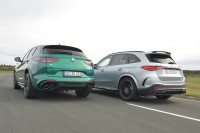If you buy a Mercedes-AMG GLC 63 E Performance for a lot of money, you get a two-liter four-cylinder instead of a four-liter V8. Alfa Romeo doesn’t do such crazy nonsense, the Stelvio Quadifoglio simply has a V6. But which brand has the last laugh?
Since autumn, Alfa Romeo the Stelvio Quadrifoglio (formerly QV or Quadrifoglio Verde) with an improved biturbo six-cylinder. The V6 now delivers 520 hp; 10 hp more than before. In addition, the Italian top model has undergone subtle optical changes and a few technical upgrades.
Of Mercedes-AMG GLC 63 E Performance is completely new, with the V8 of its predecessor replaced by a plug-in hybrid drivetrain, not to everyone’s delight. The power has increased to 680 hp, but the number of cylinders has been halved. An AMG with a four-cylinder will come as a bit of a shock to many fans, but a comparison test with the brand-new drivetrain will show whether that is justified.


Alfa Romeo Stelvio Quadrifoglio: growing up
The extra power of 10 hp is included in the Alfa Romeo Stelvio in Dutch traffic and that is not so strange. It is only an increase of 2 percent. On the standard sprint to 100 km/h it is with 3.9 seconds even a fraction slower than its predecessor (3.8 seconds).
Especially at higher speeds the new Stelvio plays out its extra power. The sound and character of the V6 with two turbos also remain unchanged: in the ‘normal’ driving programs (A and N) the six-cylinder sounds a bit strange at low revs, only from 4000 revs – and especially when you press the accelerator pedal all the way to the floor – you hear that beautiful crescendo that Alfisti are so happy about.
The solid torque of 600 Nm also ensures that the Stelvio always has sufficient power available. And that is necessary, because the V6 has to compensate for a ready-to-drive weight of almost two tons. The V6 is certainly not the epitome of silence, but it is well-mannered enough not to irritate even on longer distances.


Really: four-cylinder in Mercedes-AMG GLC
After the Alfa with its sonorous V6, the sound of the two-liter four-cylinder in the GLC takes some getting used to. Of course, it can’t match the roar of its predecessor. A shock for AMG fans that is further reinforced by the news that the Mercedes-AMG CLE 63 will once again get a V8 …
Isn’t it fun, a test like this? In our newsletter you will receive one every week. Completely free!
Still, the plug-in hybrid deserves more love, because the complex drivetrain is a feast for technology lovers. Thanks to an electrically assisted turbo and a 204 hp electric motor on the rear axle, the total power increased by 170 hp.
The torque is even more impressive and surpasses the magic limit of 1000 Nm. Where the V8 got stuck at ‘only’ 700 Newton meters, the four-cylinder and the electric motor together come to 1020 Nm.

Mercedes-AMG Plug-in hybride
On the other hand, the plug-in hybrid AMG weighs around 250 kilos more than its predecessor, which means that the sprint from 0 to 100 km/h is only three tenths faster than before. It now takes 3.5 seconds. Up to 150 km/h, the German has a half-second lead over the Italian, but at a speed of 200 km/h, the Alfa is half a second ahead again. In addition, the top speed of the Quadrifoglio at 285 km/h is even higher than that of the GLC, which throws in the towel at 275 km/h.
On the other hand, the Mercedes can also drive fully electrically up to a speed of 140 km/h, but then the battery is immediately empty. The electric range is a meager 10 kilometers (WLTP: 12 kilometers). The battery therefore seems to be mainly intended to support the petrol engine and to recharge it as quickly as possible on the road, so that even if all brakes are released on the circuit, the electric motor never runs out of power.
In everyday life, the drivetrain pleases with a smooth running and the always available extra E-Boost power. But the consumption advantage compared to the V8 of its predecessor or the V6 of the Stelvio is not that big.
You can read the full comparative test in Auto Review 7. Good to know: you get a subscription to the magazine with a big discount in our webshop.
Source: www.autoreview.nl


